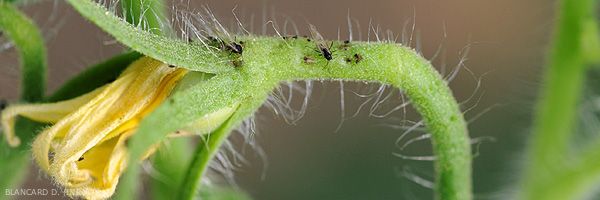
* Other species signalees on tomate en France: Aphis craccivora Koch; A. beans Walker; A. frangulae Kaltenbacb; A. cress Kaltenbacb; Aulacorthum circumflex (Buckton); Myzns ascanicus Doncaster; M. sure (Walker); Marcus host Laing; Rhopalosipmonimus latysiphon (Davidson); Smynthurodes tying Westwood ...
- Nature of damage
- Biology
- Forms of conservation and / or alternative hosts : it is often the eggs, laid in particular on many weeds at the approach of winter, which allow these insects to spend the winter. They can, of course, survive under heated shelters on existing crops, in the form of viviparous females in particular.
- Developmental stages : the eggs laid on various hosts, herbaceous or woody, hatch and give rise to founders. Subsequently, over a long period of time, viviparous females are found in the colonies.
Young larvae form, which immediately feed on the sap and molt 4 times before giving birth to the adult. White moults (exuviae) on vegetation indicate the presence of aphids in the crop. The adults are winged (1) or not; in the latter case, we speak of “wingless” individuals (2) (figure 11). Each individual can give birth to 40-100 offspring depending on the host and climatic conditions in particular.
Larvae and adults, often present on the underside of the leaf blade, feed through their rostrum. The excess sugar contained in the sap is rejected in the form of honeydew.
- Dispersion in the crop : a few plants scattered throughout the crop on which aphid colonies quickly gain importance constitute the first outbreaks. First wingless, aphids start by visiting neighboring plants. As soon as the adults appear (during outbreaks), they disperse in the crop or in nearby plots. Plants and workers can contribute to their spread.
- Favorable development conditions : these insects appreciate mild temperatures and summer conditions in shelters.
- Protection methods
Several protection methods are recommended to control the development of aphids on tomatoes in France:
- check the sanitary quality of the plants before and during their introduction into the shelter;
- produce the plants in an shelter insect-proof ;
- install canvases insect-proof at shelter openings;
- weed the greenhouse and its surroundings;
- detect the first pests thanks to the yellow sticky panels placed above the crop as soon as the plants are introduced;
- detect the first pests thanks to the blue sticky panels placed above the crop;
- use auxiliaries such as the insects Aphelinus abdominalis, Aphidius colemani, Aphidius ervi, Aphidoletes aphidimyza and Macrolophus caliginosus (the latter is of secondary efficacy) and the fungus Verticillium lecanii (note that its efficacy may vary from strain to strain. other);
- consider chemical protection (r) ( e-phy site ) *, in particular if you use auxiliaries.
(r): resistance to insecticides or acaricides is known in these pests.
* Chemical control : As the number of pesticides available for a given use is constantly changing, we advise you to always confirm your choice by consulting the e-phy site of the Ministry of Agriculture and Fisheries which is an online catalog of plant protection products and their uses, fertilizers and growing media approved in France. This also applies to all biological products based on microorganisms or natural substances.





